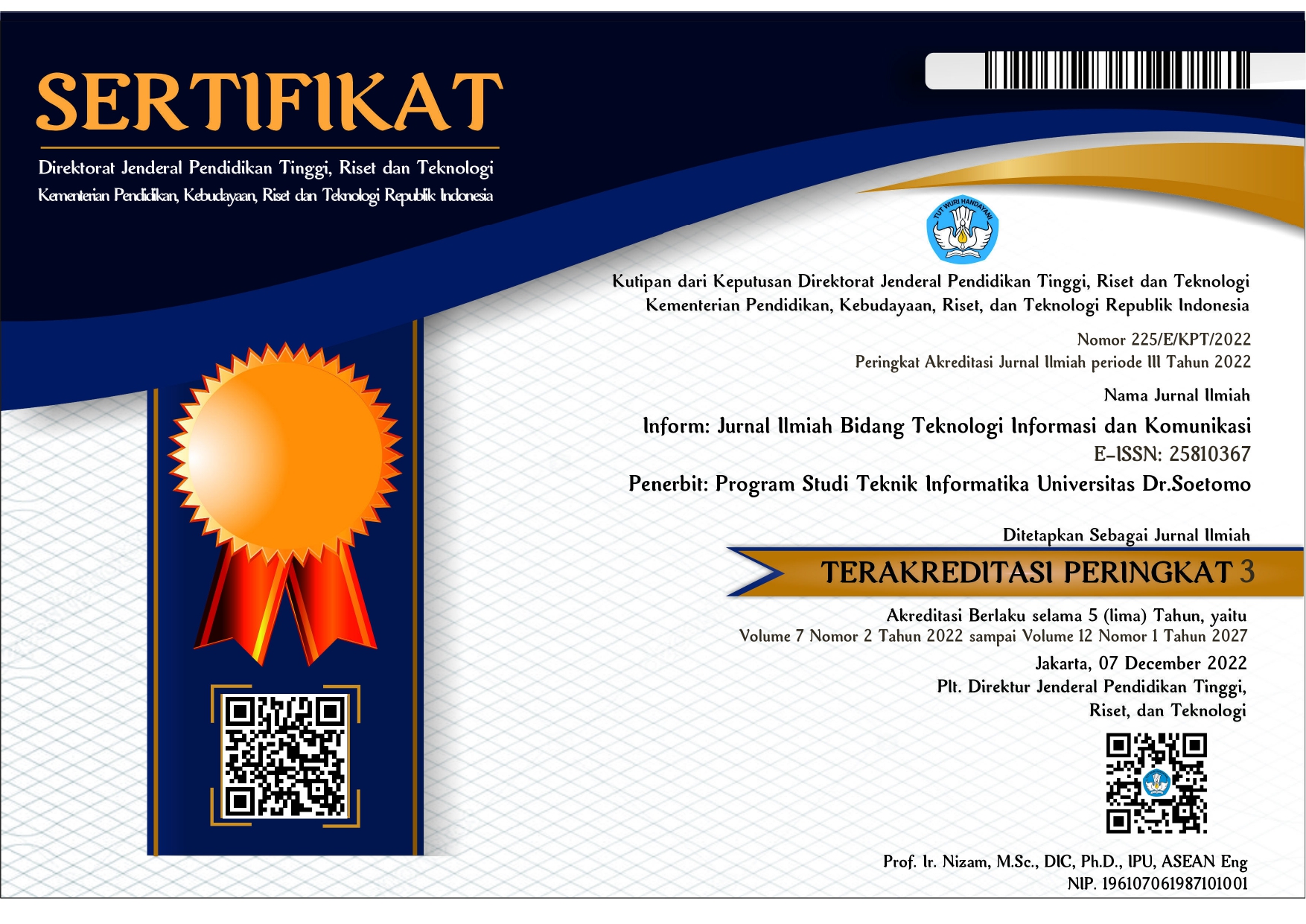Implementasi Metode Topsis Untuk Rekomendasi Pengangkatan Karyawan Tetap Pada PT. Bina Artha Ventura Cabang Nganjuk
 Abstract views: 519
,
Abstract views: 519
,
 PDF downloads: 500
PDF downloads: 500
Abstract
The career path of an employee does not necessarily immediately become a permanent employee of a company. Employees must go through the stages of contract employees and then undergo a series of tests to be appointed as permanent employees. The determination of contract employees to become permanent employees in PT BAV through a series of tests that require a long time. The assessments and calculations are carried out in stages such as file selection, written tests, psychological tests, interviews, and so on. With a long series of tests it is possible to make mistakes in the final results and the candidates do not getthe criteria required by the company so as to hamper the company's performance. In this study the TOPSIS method is applied to determine the best candidates who can be appointed by the company to become permanent employees. From the calculation results obtained by employee with ID A003 has the best result so that employee can be recommended become permanent employee, furthermore the TOPSIS method can be input for PT BAV Nganjuk Branch related to the determination of candidates who can be appointed as permanent employees.Â
@font-face { font-family: "Times New Roman"; }@font-face { font-family: "宋体"; }@font-face { font-family: "SimSun"; }p.MsoNormal { margin: 0pt 0pt 0.0001pt; text-align: justify; font-family: "Times New Roman"; }span.msoIns { text-decoration: underline; color: blue; }span.msoDel { text-decoration: line-through; color: red; }div.Section0 { }References
H. Malayu, Managemen Sumber Daya Manusia. Cetakan 9. PT Bumi Aksara, 2007.
B. A. Ventura, “Bina artha,†2018. [Online]. Available: http://www.bina-artha.net/about.php.
A. Suhartanto and S. Sucipto, “Penggunaan Expert System Dalampemilihan Varietas Padi Berdasarkan Kondisi Lahan Studi Kasus: Gapoktan Ds. Kleco, Kec. Wungu - Kab. Madiun,†Semin. Nas. Teknol. Inf. dan Multimed. 2016, p. 3.4-19-3.4-24, 2016.
S. Sucipto, “Analisa Hasil Rekomendasi Pembimbing Menggunakan Multi-Attribute Dengan Metode Weighted Product,†Fountain Informatics J., vol. 2, no. 1, p. 27, May 2017.
S. Sucipto, A. Suhartanto, and R. Firliana, “Representasi Fuzzy Tsukamoto Menggunakan Fungsi PL/PgSQL Dan Check Constraint,†in Seminar Nasional Teknologi Informasi dan Multimedia 2015, 2015, p. 4.5-7-4.5-12.
A. S. Erik Kurniawan, Hindayati Mustafidah, “Metode TOPSIS untuk Menentukan Penerimaan Mahasiswa Baru Pendidikan Dokter di Universitas Muhammadiyah Purwokerto ( TOPSIS Method to Determine New Students Admission at Medical School in University of,†JUITA, vol. 3, no. 4, pp. 201–206, 2015.
W. D. Marsono, Ahmad Fitri Boy, “Sistem Pendukung Keputusan Pemilihan Menu Makanan pada Penderita Obesitas dengan menggunakan Metode Topsis,†in Seminar Nasional Sains & Teknologi Informasi (SENSASI), 2018, pp. 135–140.
A. A. Chamid, “PENERAPAN METODE TOPSIS UNTUK MENENTUKAN PRIORITAS KONDISI RUMAH,†J. SIMETRIS, vol. 7, no. 2, pp. 537–544, 2016.
P. W. Ananta and S. Winiarti, “SISTEM PENDUKUNG KEPUTUSAN DALAM PENILAIAN KINERJA PEGAWAI UNTUK KENAIKAN JABATAN PEGAWAI MENGGUNAKAN METODE GAP KOMPETENSI (STUDI KASUS PERUSAHAAN PERKASA JAYA COMPURETAIL),†J. Sarj. Tek. Inform., vol. 1, no. 2, pp. 574–583, 2013.
Y. Astuti, M. Suyanto, and Kusrini, “SISTEM PENDUKUNG KEPUTUSAN UNTUK PEMILIHAN PERGURUAN TINGGI KOMPUTER SWASTA,†J. DASI, vol. 12, no. 1, pp. 56–62, 2011.
R. Ishak, “Sistem Pendukung Keputusan Pemilihan Penyuluh Lapangan Keluarga Berencana Teladan Dengan Metode Weighted Product,†J. Ilm. Ilk., vol. 8, no. 3, pp. 160–166, 2016.
Copyright (c) 2019 Nalsa Cintya Resti, Aidina Ristyawan

This work is licensed under a Creative Commons Attribution-ShareAlike 4.0 International License.
Authors who publish with Inform: Jurnal Ilmiah Bidang Teknologi Informasi dan Komunikasi agree to the following terms:
-
Authors retain copyright and grant the journal right of first publication with the work simultaneously licensed under a Creative Commons Attribution License (CC BY-SA 4.0) that allows others to share the work with an acknowledgment of the work's authorship and initial publication in this journal.
-
Authors are able to enter into separate, additional contractual arrangements for the non-exclusive distribution of the journal's published version of the work (e.g., post it to an institutional repository or publish it in a book), with an acknowledgment of its initial publication in this journal.
-
Authors are permitted and encouraged to post their work online (e.g., in institutional repositories or on their website) prior to and during the submission process, as it can lead to productive exchanges, as well as earlier and greater citation of published work.












